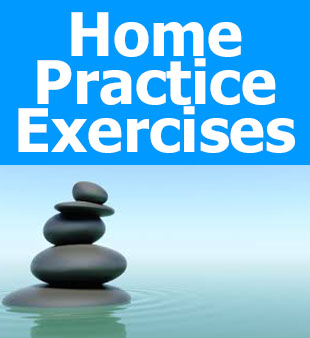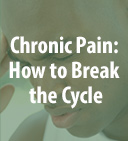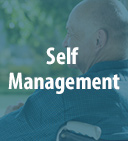Pain Management, Opioid Safety, and PDMP (PMOP)
For Veterans/Public - Complementary And Integrative Health

This section provides information and links to tools on "Complementary And Integrative Health," for pain manangement, developed for Veterans/Public.
Complementary Treatments
Complementary approaches for the treatment or management of pain consist of a variety of things, including mind-body behavioral interventions, acupuncture and massage, osteopathic and chiropractic manipulation, meditative movement therapies (e.g., yoga, tai chi)
 |
− Yoga/Tai Chi − Physical Activity - Physical Therapy & Chair Exerciseses − Acupressure |
| Alternative Treatments | Stretching | |
| These include acupuncture, chiropractic treatment, meditation, and whole health. | Yoga and tai chi are suggested to stretch and strengthen muscles. |
• Acupressure - form of Traditional Chinese Medicine (TCM) which relies on applying pressure to certain points of the body to relieve the symptoms of pain.
• Acupuncture* - placement of small needles into the skin at various points in the body
Battlefield Acupuncture (BFA) - an acupuncture protocol where needles are placed in the ear to reduce pain. Whole Health Acupuncture
• Chiropractic Care - hands-on manipulation of the body as a means to properly align the spine and to restore mobility to joints. VA Chiropractic Care Locations.
• Meditation - teaches awareness techniques to relax the body and quiet the mind. Helps reduce pain, improve mood, and decrease stress.
• Whole Health - the aim is to help veterans focus on life goals as they work to manage their chronic pain and other ailments. VA Whole Health Site. Whole Health video sessions for yoga, meditation, tia chi, acupressue—that you can follow along at home
• Yoga - involves breath control, meditation, and a series of physical poses. Listing of Yoga YouTube Exercises.
• Tai Chi - an ancient practice originating in martial arts, this mind-body practice involves both physical and psychological exercises. Veterans Tai Chi for Pain and Stress
• Relaxation Treatments - comes in many forms (imagery, progressive muscle relaxation, deep breathing). These exercises reduce the stress and muscle tension that are common with pain.
• Spirituality - the use of spiritual practices in helping patients cope with pain, reduce pain intensity, and lessen the degree to which pain interferes with the activities of daily living.
Behavioral Health Approaches
| Behavioral Therapies |
| Behavioral therapies can include emotional awareness and mindfulness, or other behavioral interventions. |
Behavioral therapies can be used to treat pain. The goal of caring for your mental health is to improve the pain experience and restore function by addressing the cognitive, emotional, behavioral, and social factors that contribute to the stress of pain.
• Cognitive Behavioral Therapy (CBT) Acceptance and Commitment Therapy - focuses on changing your thoughts about pain and then helping you adopt positive ways of coping with pain. VA CBT for Veterans Site.
• Mindfulness-Based Stress Reduction (MBSR) - is a program designed to teach a skill called mindfulness. MBSR teaches practices that reduce stress and promote health and wellness.
•Emotional Awareness and Expression Therapy (EAET) - encourages patients to view their pain as affected by emotional experiences that impact neural pathways in the brain.
• Self-regulatory or Psychophysiological Approaches - VA Self-Management Site.
• Acceptance and Commitment Therapy (ACT) for Pain* - therapy that emphasizes acceptance and mindfulness paired with commitment action to make lasting changes that will improve quality of life.
• Biofeedback - used to learn how to control body functions such as muscle tension and other bodily responses to stress.
• Clinical Hypnosis - the use of hypnosis for the treatment and alleviation of a variety of physical and psychological symptoms.
• Guided Imagery - (a mind-body technique also known as visualization) is a well-recognized and scientifically validated way to relieve pain.
Restorative Therapies
| Exercise | Massage | Physical Therapy (PT) | ||
| Physical activity can help reduce pain and increase mobility. Some examples are gentle aerobic walking, swimming, or cycling. | Therapist can ease pain by relaxing tense muscles and joints, which can relieve stress and anxiety. | A physical therapist can guide you through exercises to preserve and improve strength and mobility. |
Restorative therapies to treat pain include many different approaches, such as the use of a heating pad or ice pack, exercise, and physical therapy.
• Therapeutic Exercise: helps people with chronic pain find a physical activity program that is gentle, moderate, and right for the individual. Learn more at the VA Rehabilitation and Prosthetic Services site.
• Types of physical therapy that may help pain include:
- Cold treatment: ice packs, ice baths, ice massage.
- Heat treatment: hot water baths, heating pads, high-frequency sound waves to produce gentle heat deep in your tissues.
- Gentle stretching
- Muscle strengthening
- Body mechanics
- Vibration therapy: a probe is applied to a part of your body with moderate pressure and vibrated several thousand times per second.
- Traction: PT therapy used for spinal pain
• Aqua Therapy - water based type of physical therapy. Exercises are done in a pool usually with the help of a specially trained physical therapist.
• Massage Therapy - applying pressure to specific points on the body. It can help reduce stress and muscle tension which can reduce pain.
• Transcutaneous electrical nerve stimulation (TENS) is a therapy that uses low-voltage electrical current for pain relief.
•Therapeutic Ultrasound (TU) to deliver heat to deep tissues for improved injury healing.
*Not all therapies are available at all VA Medical Centers, and certain therapies may not be appropriate for all conditions. Talk to your provider to determine which approaches are best for you. If a given therapy is not available at your Medical Center/Healthcare System ask your provider if similar care may be accessed in your community.
Resources - Complementary Treatments
• Traditional Chinese Medicine (pdf) - Department of Veterans AffairsBooklet about Chinese Medicine that describes approaches to health from a Chinese Medicine philosophy.
• Whole Health Workbook (pdf) - VA Puget Sound Health Care System -Department of Veterans Affairs A guide to Proactive living and well-being.
• The Free Mindfulness Project * ![]() http://www.freemindfulness.org/ - Collection of free-to-download mindfulness meditation exercises.
http://www.freemindfulness.org/ - Collection of free-to-download mindfulness meditation exercises.
• Mindfulness and Chronic Pain (video) * ![]() UMNCSH. This YouTube video describes how mindfulness can help with chronic pain.
UMNCSH. This YouTube video describes how mindfulness can help with chronic pain.
• Complementary Care for Pain - Veterans Health Library - Pain relief with complementary care. Always tell your healthcare professional that you are using complementary care.
• Mindfulness * ![]() - Swedish Medical CenterMindfulness stress reduction techniquies and exercises. Instead of focusing on medication, learn how to reduce the stress and you will find you need less medication.
- Swedish Medical CenterMindfulness stress reduction techniquies and exercises. Instead of focusing on medication, learn how to reduce the stress and you will find you need less medication.
• Phone-based Meditation Class on Yoga Sleep(iRest) - Yoga “Sleep” Guided Meditation Classes available from home.
• WRIISC yoga nidra classes - are available to all VA enrolled Veterans, Whole Health Proactive Living and
• Whole health for life website ![]() - Visit this site to use online resources, tools and other information to support whole health.
- Visit this site to use online resources, tools and other information to support whole health.
• Whole health system video series: ![]() - Watch these brief videos and podcasts to learn more about whole health from other Veterans, VA leaders and clinicians across VA.
- Watch these brief videos and podcasts to learn more about whole health from other Veterans, VA leaders and clinicians across VA.
• Personal health inventory: ![]() - Think about your health in a new way, focusing on what matters most in life and what brings you joy and happiness. Listen to a podcast about this approach and complete a personal health inventory to identify areas of focus to help you achieve your goals.
- Think about your health in a new way, focusing on what matters most in life and what brings you joy and happiness. Listen to a podcast about this approach and complete a personal health inventory to identify areas of focus to help you achieve your goals.
• Whole Health For Life - Mobile Apps and Online Tools ![]() - Use these web-based and mobile tools to manage pain. Other
- Use these web-based and mobile tools to manage pain. Other
• All Pain Treatments * ![]() - Practical Pain Management (PPM)Information on: Complementary Treatments, Interventional Pain Management, Manipulation and Massage, Pharmacological, Psychological, Rehabilitation.
- Practical Pain Management (PPM)Information on: Complementary Treatments, Interventional Pain Management, Manipulation and Massage, Pharmacological, Psychological, Rehabilitation.
• Complementary Health Approaches to Chronic Pain * ![]() - National Institute of Health (NIH)Evidence to support complementary health approaches for different pain syndromes.
- National Institute of Health (NIH)Evidence to support complementary health approaches for different pain syndromes.
• "Arthur's transformation"*(video) ![]() - https://ddpyoga.com Never, Ever Give Up. Arthur's Inspirational Transformation! YouTube video
- https://ddpyoga.com Never, Ever Give Up. Arthur's Inspirational Transformation! YouTube video
• US Pain Foundations - Complementary Therapies - US Pain FoundationList of complementary therapies and definitions.
Veterans/Public Pain Management - Resource Topics
 |
 |
 |
Literature Alerts for VA Staff
The VA Library Network will provide VA staff an index of recent articles related to opioids and many other areas of interest right to your work mailbox. If you are interested in subscribing to this alert click here.
If you have questions or suggestions for pain-related resources, please send an email to VHA Pain Management Webmaster Group. Questions about personal care should be directed to the local VA facility.
Disclaimer: *Links will take you outside of the Department of Veterans Affairs Website. VA does not endorse and is not responsible for the content of the linked websites.



















